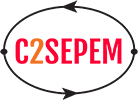Our Center for Computational Study of Excited-State Phenomena in Energy Materials (C2SEPEM) will build on recent progress made on computation of excited-state properties of complex functional materials using ab initio many-body perturbation theory (MBPT), advancing an existing successful software package, BerkeleyGW. We aim to expand the state-of-the-art (both computational and theoretical) in MBPT in several major directions:
i) Advancing and going beyond GW and Bethe-Salpeter equation approaches:
Ab initio many-body perturbation theory has been extremely successful in describing quasiparticle (within the GW approximation to the electron self-energy) and optical (within the GW plus Bethe-Salpeter Equation (BSE) approach) excitations in the frequency domain. An important new direction will be to move to the time domain, which will address pump-probe studies, ultrafast electron dynamics, real-time decay of excitations, etc. The Center plans to develop a time-dependent GW approach and related techniques that address excited-state dynamics and relaxation.
ii) Novel computational methods:
Central to the success of the mission of the Center will be the development of scalable methods and algorithms and their implementation targeting exascale architectures. Several directions will be pursued to reach exascale-class excited-state computations for systems with tens of thousands of atoms. First, we will advance the existing BerkeleyGW software package for heterogeneous and many-core processors, high bandwidth memory and accelerated IO via burst buffer technology. Currently, BerkeleyGW has proven to scale to 105 CPU cores through a combination of Message Passing Interface (MPI), OpenMP and Vector parallelism and effective use of large vector units on pre-exascale architectures. The GW approach is particularly ripe for exascale because one can exploit multiple layers of parallelism over valence electrons (bands + k-points), conduction electrons (bands + k-points), plane-waves and frequencies. To reach order 107 parallelism, we plan to exploit all these layers simultaneously. Secondly, we will adopt and develop stochastic techniques for many-body perturbation theory. The stochastic techniques together with real-space grid as well as matrix based methods can provide sub-linear to quadratic scaling for calculating excited-state properties and are also easily implemented on parallel machines with little communication requirements.
iii) Software Deliverables:
This Center aims to deliver user-friendly, open-source software, leveraging the existing BerkeleyGW package. BerkeleyGW is a well-established, open-source software that already scales to 100,000 CPUs. It has an active community of registered users worldwide, with a dedicated web portal, a forum, and an annual international workshop. We will build on this successful platform while dramatically expanding its capabilities to describe 3- and 4-particle excitations as well as time-domain and non-adiabatic processes, in both periodic and open boundary conditions, and develop new methods capable of taking advantage of high-performance computing architectures while integrating with existing codes. We will leverage access and partnerships with the Molecular Foundry, the Advanced Light Source, the Materials Project, NERSC, and the emerging CAMERA center, major relevant LBNL user facilities and centers.
Validation will be done via spectroscopic and other excited-state experiments in collaboration with the above mentioned major LBNL user facilities and centers on a variety of systems, in particular novel light-harvesting materials including halide perovskites, metal oxides, and layered 2D systems. Focus will be on emerging classes of materials of interest for energy conversion: van der Waals quasi-2D materials (graphene, BN, MoS2, etc.) where electron-electron interactions can be controlled by tuning layer thickness, substrate and doping; and on metal oxides, halide perovskites, and molecular materials where electron-phonon and spin-orbit coupling are central and the role of large-scale atomic structures (such as grain boundaries and defects) on excited-state phenomena is to be understood.

